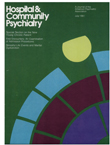The Chronic Patient With a Nonpsychotic Diagnosis
Abstract
In a population of almost 1,100 patients in an urban hospital's aftercare program for the chronically mentally ill, 137 patients (12.5 per cent) were found to have nonpsychotic diagnoses. Patients with nonpsychotic diagnoses tended to be older at the first psychiatric contact, a preponderance were first-born or only children, and a higher percentage had been or were presently married. The therapist's possible role in the prevention of chronicity in nonpsychotic patients is discussed; therapists may contribute to the creation of chronic patients, the authors say, by fostering the emergence of increased dependency needs in patients who initially present with acute symptoms. The limitations of psychotherapeutic intervention must be stressed to psychotherapy students, and psychotherapy with nonpsychotic patients should be time-limited and focused on problem-solving.
Access content
To read the fulltext, please use one of the options below to sign in or purchase access.- Personal login
- Institutional Login
- Sign in via OpenAthens
- Register for access
-
Please login/register if you wish to pair your device and check access availability.
Not a subscriber?
PsychiatryOnline subscription options offer access to the DSM-5 library, books, journals, CME, and patient resources. This all-in-one virtual library provides psychiatrists and mental health professionals with key resources for diagnosis, treatment, research, and professional development.
Need more help? PsychiatryOnline Customer Service may be reached by emailing [email protected] or by calling 800-368-5777 (in the U.S.) or 703-907-7322 (outside the U.S.).



